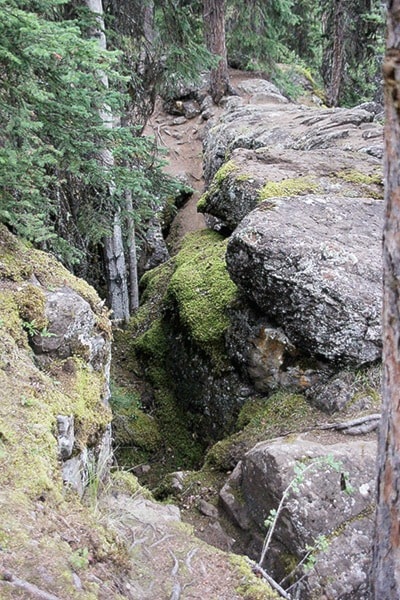The knowledge and use of the Bridge Lake Ice Caves has a lengthy history for area First Nations and much later area pioneers who used the ice that could be chipped out of the crevices and used for parties and other gatherings.
The unique geology of the southern slope of Bridge Lake shoreline features caves and crevices that are sheltered from sun and wind.
Melting snow seeps through the rock crevices into the caves where it refreezes, creating almost a year-round supply of ice.
The ice caves are located a few kilometres past the Interlakes Service Centre on Highway 24 across the highway from Highcountry Road.
The Ice Caves area is getting a facelift with a low-mobility and outdoor fitness trail with numerous family friendly amenities through a Jobs Creation Partnership (JCP) Project.
The JCP Project is also providing an upgraded parking lot, trail and bridge construction and outhouse facilities.
The Ice Caves Project is led by the Fishing Highway 24 Tourist Association (FHTA), one of the partners in the JCP Project.
The other project partners are the New Pathways to Gold Society (NPTGS), Canim Lake First Nation, Gold Rush Snowmobile Trail Regional Management Committee and the governments of Canada and British Columbia.
Helga Zeiner, who is the Ice Caves Heritage Trail co-ordinator, says the Friends of Bridge Lake had the original stewardship for the Ice Caves, but gave it up.
The Fishing Highway Tourism Association (FHTA) took over the stewardship from BC Rec & Trails under the provision the association looks after the site and the trail into the ice caves.
Noting there was a desire to develop the site, Helga says the biggest problem was there was no parking area and people had to park on Highcountry Road and then run across the highway to get to the trail head. "It was really dangerous."
The problem, however, was the FHTA didn't have the manpower and funding to start developing the site either.
Her husband, Manfred, then came up with the idea of trying for funding for an outdoor fitness trail system, so a visit to the area would be more than just visiting the Ice Caves.
Then the Zeiners met with Cariboo-Chilcotin MLA Donna Barnett and asked her how to go about getting funding for the project.
"Donna found $10,000 to do a location survey to see what is possible and what is not possible at the site, and we volunteered to do all of the background work."
FHTA president Manuela Betschard gave the Zeiners permission to go ahead and take over the project, she says, adding that's how it all started.
Helga says Barnett came up with the idea of approaching the NPTGS for help.
"I managed to sneak in on their Job Creation Project [which took care of the manpower issue]. Then we had to get the signage funding to tie the whole project together to make it attractive.
"We needed a parking area and a mobility trail. We needed to indicate the fitness stations and all sorts of things. Suddenly, it's a big, big project, and I'll be really glad when it's done."
The Zeiners have been working on the project for 2.5 years.
Helga expresses her appreciation for all of the people who help bring the project to fruition: MLA Barnett; Cariboo Regional District (CRD) Area L director Brian Coakley; FHTA president Betschard; NPTGS executive director Gord Rattray; Canim Lake Band carver Jerome Boyce; logo designer Jil Freeman; BC Rec & Trail district recreation officer Curtis Oftsie; fitness trainer Cambria Volante; and CRD economic development officer Jordan Hammond.
